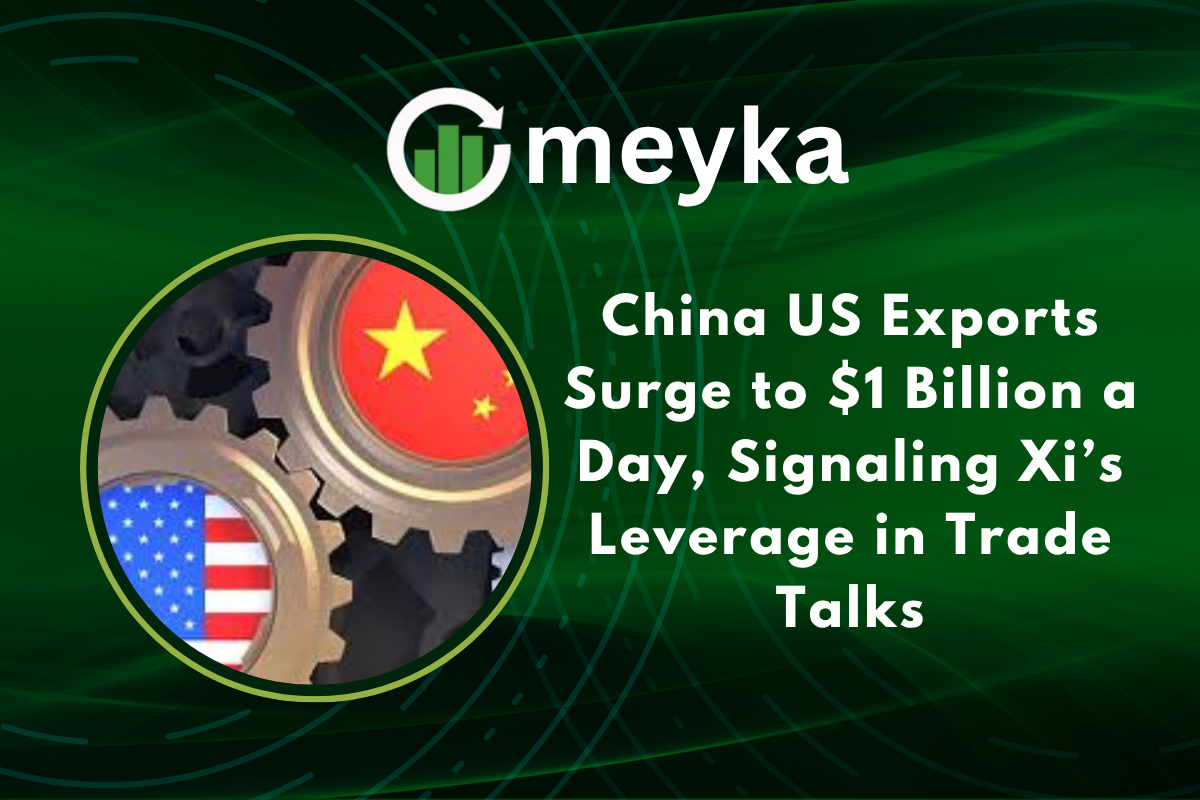China US Exports Surge to $1 Billion a Day, Signaling Xi’s Leverage in Trade Talks
China US Exports have climbed to about $1 billion a day, a figure highlighted by recent reporting. That pace shows Beijing’s marketplaces remain deeply connected to U.S. demand. The flow of goods gives Xi Jinping more room in talks with Washington.
It also complicates U.S. plans to coerce quick concessions through tariffs or export restrictions. Markets and policymakers are taking notice. The balance of trade and the politics of supply now matter as much as tariffs do.
China-US Exports Hit Record Highs Amid Trade Tensions
Reports from major outlets show China’s shipments to the U.S. are running at unusually high daily rates, even as relations fray. Bloomberg and the Japan Times noted the roughly $1 billion a day pace, citing customs and trade flow analysis.
That level comes after months of resilient factory output and strong global demand for electronics, machinery, and other manufactured goods. The numbers matter because they show China can still supply U.S. markets at scale despite trade frictions.
Tweet on the trade context:
Why are China’s exports growing so fast? The rebound reflects steady global demand, robust factory output, and flexible logistics. It also shows how exporters can redirect shipments across routes and buyers when some markets tighten.
How China’s Manufacturing Engine Drives Export Growth
China’s factories remain highly integrated into global supply chains. The country has large-scale production capacity across electronics, automotive parts, and consumer goods. That helps keep exports flowing even under pressure.
Industrial policy and state support also play a role in smoothing logistics and credit for exporters. In addition, rare earth materials and technology inputs are key parts of the equation. Controls or limits on these supplies can give Beijing bargaining chips. Analysts say China’s manufacturing engine keeps global buyers connected to Chinese suppliers.
What role do rare earths and tech exports play? Rare earths are essential for chips and EV motors. Limits on these goods would pinch global tech supply chains and raise costs quickly.
Xi Jinping’s Strategic Leverage in Trade Talks
A steady stream of exports gives Xi Jinping leverage in talks. If China can keep sending goods and find buyers globally, the pressure from U.S. tariffs falls. That reduces the bargaining power of sudden trade threats.
Reports suggest that Beijing knows how to use its export strength as a diplomatic tool. In short, when China keeps its factories running and shipments moving, it gains negotiating room. That dynamic makes it harder for Washington to force rapid, unilateral concessions.
Why is this export surge giving Xi more power? Because tariffs hit less hard when buyers can still source goods. Strong shipments mean Beijing can wait out political pressure and negotiate from a steadier position.
Global Market Reactions and US Policy Responses
The export surge has prompted reactions in Washington and among allies. U.S. officials are seeking alternative suppliers and critical mineral deals, as seen in recent cooperation with Australia on rare earths.
Political leaders have warned that China would face consequences if it used exports as a weapon, yet policymakers also acknowledge the risk of supply shocks. Former and current U.S. officials have reiterated both pressure and contingency plans. The public tone mixes threats with efforts to diversify supply chains.
How might the U.S. respond? Responses include securing alternative mineral sources, tightening controls where possible, and aligning allies on sourcing to reduce over-reliance on any single supplier.
Economic Experts Weigh In on the China US Exports Data
Economists and trade analysts stress nuance. Some see the export boom as evidence of China’s ability to meet demand and sustain growth in the near term.
Others caution that high export flows can mask slower domestic activity or weaker consumer demand inside China. Analysts also examine currency impacts.
A strong export streak could affect the USD CNY dynamic and trade balances. Forecast models and scenario analysis from policy shops now factor these flows into trade and growth outlooks. AI Stock research tools are being deployed to parse shipment data and investor flows in real time, refining forecasts for markets and firms.
Do experts expect this to last? Views differ. Some expect continued resilience, while others warn that shocks or policy shifts could reverse the trend.
Technology, AI, and Future Trade Dynamics
Automation and advanced logistics help move goods at scale. AI-driven routing and inventory systems reduce bottlenecks. That means exports can remain robust even when political relations sour.
At the same time, restrictions on high-value tech and advanced components create a newer battleground. Investors and policymakers track these moves closely using machine models and data feeds.
Terms like AI Stock and AI Stock Analysis appear in market workstreams as teams scan how trade policy affects tech valuations and supply exposures. Technology thus both supports exports and becomes a focal point of strategic control.
What the Export Boom Means for Global Markets and Investors
For global markets, a sustained export boom means a steadier supply of manufactured goods and a lower near-term risk of acute shortages. For investors, however, the picture is mixed. Companies reliant on Chinese supply chains may benefit from stable inputs, while manufacturers in other countries face stiffer competition.
Commodities tied to production and transport may see demand shifts. Emerging markets that serve as alternative manufacturing hubs could see more interest. In geopolitics, the boom raises the stakes of any tariff escalation because disruption would ripple through global production systems.
What happens if trade tensions rise again? Renewed tariffs or export controls would risk higher costs, supply delays, and market volatility. Governments would likely accelerate diversification plans.
Conclusion
The surge in China-US Exports, now reported at roughly $1 billion a day, is a clear sign of Beijing’s sustained role in global manufacturing. That scale gives Xi Jinping added leverage in negotiations with Washington. It also raises complex policy choices for the United States and its allies, who must balance pressure with the risk of supply shock.
For markets and investors, the export boom brings both opportunity and risk. The key will be watching policy moves, rare earth strategies, and how firms adapt supply chains in response to shifting geopolitics.
FAQ’S
China mainly exports electronics, machinery, furniture, toys, and textiles to the United States.
The U.S. exports around $150–170 billion worth of goods annually to China, including soybeans, aircraft, and semiconductors.
The United States remains China’s largest single export market, followed by the European Union and ASEAN countries.
Mexico sends roughly 80% of its total exports to the United States, mainly vehicles, electronics, and machinery.
Americans buy electronics, smartphones, clothing, and home goods the most from China.
Yes, China’s trade surplus recently topped about $1 trillion, driven by strong exports and lower import growth.
Disclaimer
The content shared by Meyka AI PTY LTD is solely for research and informational purposes. Meyka is not a financial advisory service, and the information provided should not be considered investment or trading advice.”






